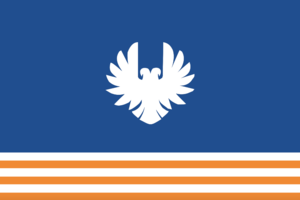Laveska
|
Federal Republic of Laveska
Федератсиыа Лавескаыа (Federatsiya Laveskaya)
|
|||||
|---|---|---|---|---|---|
| [[File:]] | |||||
| The six States of the Federacy governed by the Consular Phoenix and the Blue of the Seas. | |||||
| Motto | Ex Unitate Vires | ||||
| Common Name | Laveska | ||||
| Anthem | Дороги (Dorogi) | ||||
| Demonym | Laveskan | ||||
| Official languages | Aesori, Zeroan, Zokesian, Strelkan | ||||
| Politics | |||||
| Capital | Lavesk | ||||
| Government | Federal presidential constitutional republic | ||||
| Foundation | 1707 | ||||
| Consul | Khristianskiy Asimov | ||||
| Preceded by | Laveskan Seafarer's Republic | ||||
| Demography | |||||
| Ethnicities | Laveskan, Zeroan, Strelkan, Zokesian | ||||
| Population | 5,253,774 | ||||
| Area | 61,215 km² km² | ||||
Laveska, officially the Federal Republic of Laveska, is a prosperous nation of farms, ports, and mountains located in the western Wakir. Bordered by Tizca to the north, Maryurt to the west, Doren to the south, and Noland in the east, Laveska is a gateway to many cultures, nations, and resources. She consists of six Federal States, one self-governing colony, and one unincorporated territory under military administration. Mainland Laveska extends from the Larkuno Mountains to the Wakir Ocean and from the Feniks River to the Tizcan Mountains.
Etymology
The name Laveska originates from the Eastern Aesori word Lavesk'ani, meaning "Eternal Fountain," referring to the Wakir Ocean. Though Eastern Aesori is a largely dead language now, due to the fact that the language was a brute-force combination of Old Aesori, Reciprocan, and Feguan, the name stuck and when a group of merchants established a major settlement on a peninsula bordering the Wakir Sea, they named the city Laveska, a shortening of her original name. As time went on and Laveska became less of a city and more of a state, the name became attached to the whole region north-west of Algiza.
Government
The Laveskan Federal Government consists of a tricameral legislature, the Senate which is voted in by the people every four years, and a Presidium of which half of its representatives are voted in by the people and the other half by state governments. There are not many parties but a variety does exist, and coalitions are necessary to maintain any reliable grasp on power. The third house is the Grand Syndicate, where trade unions send their representatives to the government. The Syndicate is independent of the Senate and Presidium, but has little power and can be overruled by a vote in either the Senate or Presidium. The executive consists of a pair of Consuls, one for internal affairs, and the second for foreign. The current IntAf Consul is Anatoliy Reva of the Union half of the Union-Mercantilist party, and the current ExtAf Consul is Khristianskiy Asimov of the Mercantile half of the Union-Mercantilist party. The High Court handles judicial matters, and the military is led by the Laveskan High Command, with the ExtAf consul at its head.
Each Outlying State gets 5 Presidents that it can send to the Presidium, with Lavesk getting 10 due to its central status in the Federation's creation. Presidents are elected by popular district, lending a total of 200 Senators and 70 Presidents as of 2144.
States
Laveska's current constitution grants its States a high level of autonomy, but strictly enforces the absolute nature of the rights granted to its people under the Constitution. Policing is done at the local level through federally-deputized people's militias, which themselves are organized into a union of militias, the Federatsiya Militsii, that can be rapidly mobilized in cases of war or national emergency. This allows the federal government to protect the rights of its citizens without having to micromanage each of its component areas.
Economy and Infrastructure
Laveska's economy depends almost entirely on its access to the sea. A network of so-called "transport highways," four-lane roads explicitly dedicated to shipping agencies and their transport vehicles were built by the naval junta in the 2040s, quickening the pace of global trade.
Northern Laveska, and to a lesser extent Southern Laveska, are known for their farming operations, providing food for the more mountainous regions of Laveska as well as some neighboring countries. Small farming communes are still very common in Laveska, often appearing near transport highways but not civilian ones.
The urban areas of Laveska are notable for their employment of "Sotsgorod," the Arcadian Communist style of architecture. Due to the abject failure of the Communist system in Arcadia however, Laveskan Sotsgorod architecture was of far higher quality than its Arcadian counterpart.
The coastal areas of Laveska are renowned for their industrial prowess, with shipbuilding at the forefront.
